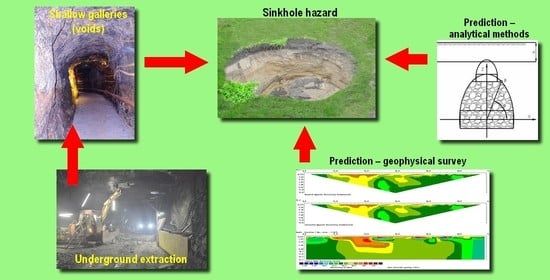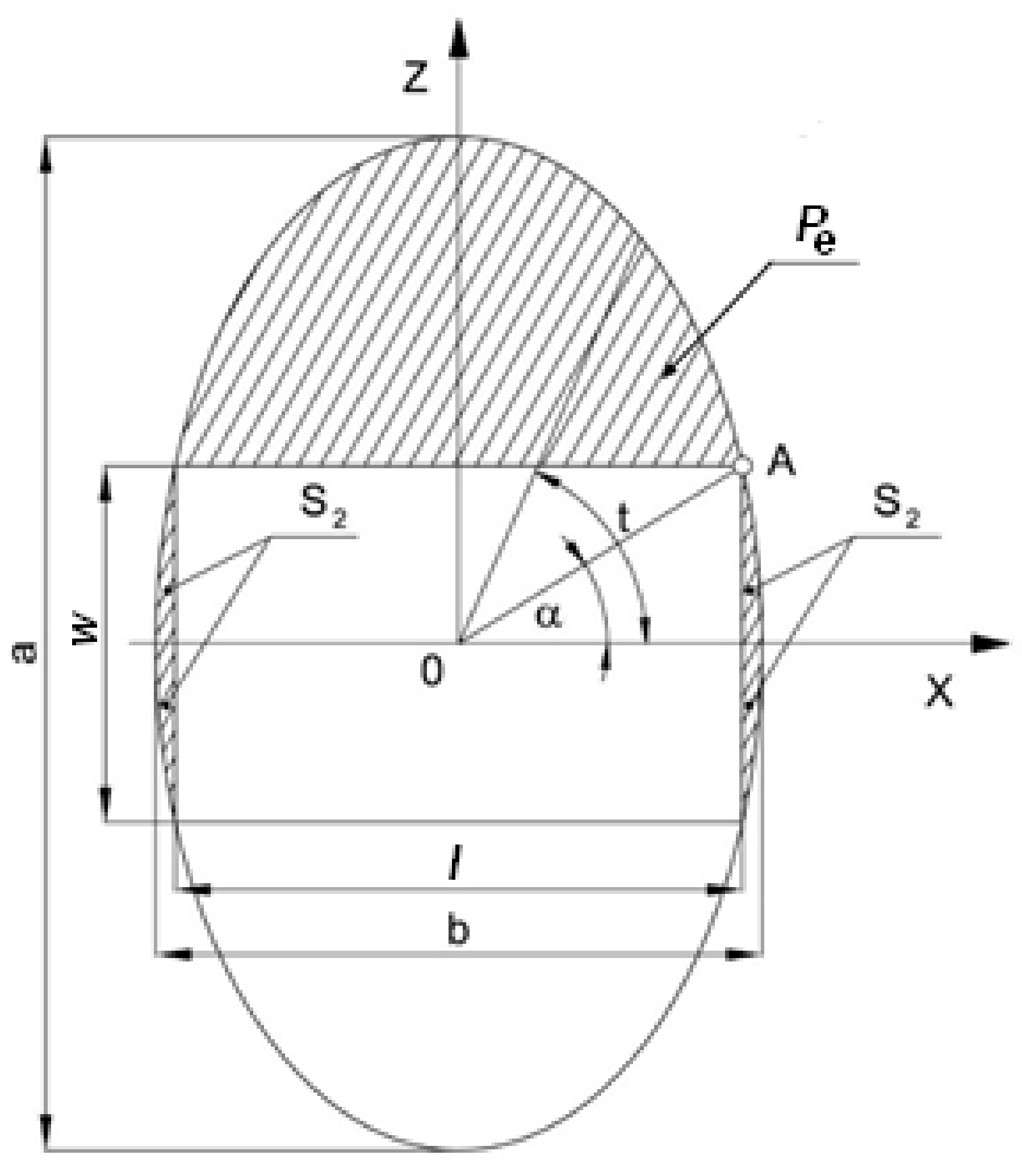Surface Deformations Resulting from Abandoned Mining Excavations
Abstract
1. Introduction
2. Material and Methods
2.1. The Method of Sinkhole Hazard Assessment
2.2. Basic Information on Measurements Using Electrical Resistivity Method
3. Research Area
3.1. A Short Analysis of the Causes of Sinkholes Creation in the Research Area
- depth up to 50 m;
- depth from 50 to 80 m;
- depth from 80 to 100 m;
- depth more than 100 m.
3.2. Local Conditions of the Research Area
3.3. Geological Structure of the Rock Mass
3.4. Shallow Mining Extraction
4. Results of Investigations
4.1. The Forecast of Sinkhole Formation Hazard
- Vertical component of the primary pressure—pz = −0.412 MPa
- Horizontal component of the primary pressure—px = −0.059 MPa
- The fracture ellipse axes length ratio n = −1.25
4.2. The Study of the Rock Mass Structure in the Vicinity of Underground Workings Using the Electrical Resistivity Tomography Method
- Due to the length of the measuring line equal to 70.5 m, the estimated depth of penetration was about 11–12 m;
- In both presented cases, the ERT image obtained indicates two characteristic structures in the subsurface layers:
- ∘
- a thin layer of anthropogenic bulk material;
- ∘
- a layers of the base subsoil, in this case constituting Carboniferous layers, in particular weathered, weak Carboniferous sandstones, highly waterlogged;
- In the ERT images at the location of the “M” shaft, there are no clearly visible anomalies that would indicate the loosening of the backfill material used to liquidate the shaft. Only a slight disturbance (lower values of apparent resistivity) in the anthropogenic subsurface layers can be identified. This disturbance may be associated with the location of the shaft, however, this is very local, minor anomaly. The above indicates no hazard to the surface due to the possibility of sinkhole formation in the location of the shaft.
- The second characteristic place is the intersection of the profile line with the gallery—in the vicinity of electrodes No. 32–35. At that location, a slight resistivity anomaly may be observed, which may be the result of the loosening of rocks over the shallow gallery (at a depth of about 11 m). However, similar to the above described location of shaft “M”, the anomaly is limited to the shallow subsoil layer, so it is hard to prove without using different geophysical method or direct drilling, that it is related to the existence of underground gallery.
- The results of the statistical analysis of measurement errors presented in Figure 15, performed with the Res2Dinv program for the Wenner–Schlumberger array, indicate that the quality of the measurement and the calculated inversion of the apparent resistance model does not raise any objections—the percentage error in matching the model to the measurement results was in the range of 1.1–1.5%. For the Wenner α array, the errors obtained are characterised by a similar distribution. Due to the limited volume of this paper, no further details will be provided.
5. Conclusions
- The primary reason for the formation of sinkholes over the mining area of considered coal mine are abandoned mining workings located at a depth of up to approximately 80 m. Underground workings located deeper do not pose a threat of sinkhole creation.
- In the specific case of workings located in the vicinity of the “M” shaft, existing voids in the rock mass will remain stable. Therefore, it should not lead to their transformation into the state of collapse and, as a result, to the occurrence of sinkholes. However, this conclusion should be treated “locally”, referring only to a small part of the whole area. In order to obtain a broader risk assessment, such analyses should be carried out independently for a given location on the basis of local geological and mining conditions.
- The location of the anomaly found in the ERT surface survey (Figure 13 and Figure 14) coincides with the location of the gallery in the seam 308 at the depth of approximately 11 m. This location should be indicated as posing a threat of future sinkholes. There are no clearly visible anomalies in the locality of the “M” Shaft, which would indicate loosening of the backfilling material used for liquidating of the shaft. Therefore, the occurrence of a sinkhole at the location of the shaft can be regarded as unlikely.
- The application of the presented methodology combining an analytical model and geophysical surveys makes it possible to assess the degree of hazard posed by a sinkhole on the surface of a post-mining area. The results of such tests can be useful in defining the land use and developing technical projects for reclamation and revitalisation of post-mining areas. However, for a more precise risk assessment, it is recommended to use an additional geophysical method and perform drilling confirming the occurrence of voids determined by non-invasive methods.
Author Contributions
Funding
Institutional Review Board Statement
Informed Consent Statement
Data Availability Statement
Acknowledgments
Conflicts of Interest
References
- Wu, Z.; Zhang, W.H.; Liu, Y.S.; Ren, D.; Xun, J.Z.; Bai, J.X. Analysis of the response of glaciers to climate change based on the glacial dynamics model. Environ. Earth Sci. 2020, 79, 438. [Google Scholar] [CrossRef]
- Wang, J.; Huo, A.; Zhang, X.; Lu, Y. Prediction of the response of groundwater recharge to climate changes in Heihe River basin, China. Environ. Earth Sci. 2020, 79, 13. [Google Scholar] [CrossRef]
- Kratzsch, H. Mining Subsidence Engineering; Springer: Berlin/Heidelberg, Germany; New York, NY, USA, 1983; p. 543. [Google Scholar]
- Whittaaker, B.N.; Reddish, D.J. Subsidence. Occurrence, Prediction and Control; Elsevier: New York, NY, USA, 1989; p. 528. [Google Scholar]
- Knothe, S. Forecasting the Impact of Mining Exploitations; Publishing House “Śląsk”: Katowice, Poland, 1984; p. 122. [Google Scholar]
- Orwat, J. Depth of the mining exploitation and its progress in the time, and a random dispersion of observed terrain subsidence and their derivatives. IOP Conf. Ser. Earth Environ. Sci. 2019, 261, 012037. [Google Scholar] [CrossRef]
- Orwat, J.; Gromysz, K. Occurrence consequences of mining terrain surface discontinuous linear deformations in a residential building. J. Phys. Conf. Ser. 2021, 1781, 012013. [Google Scholar] [CrossRef]
- Ścigała, R.; Szafulera, K. Linear discontinuous deformations created on the surface as an effect of underground mining and local geological conditions—Case study. Bull. Eng. Geol. Environ. 2019, 1–10. [Google Scholar] [CrossRef]
- Strzałkowski, P.; Szafulera, K. Occurrence of linear discontinuous deformations in Upper Silesia (Poland) in conditions of intensive mining extraction—Case study. Energies 2020, 13, 1897. [Google Scholar] [CrossRef]
- Chudek, M.; Janusz, W.; Zych, J. Study on diagnosis and prognosis of the formation of discontinuous deformation due to underground mining. Res. J. Silesian Univ. Technol. Gliwice 1988, 141, 165. (In Polish) [Google Scholar]
- Singh, K.B.; Dhar, B.B. Sinkhole subsidence due to mining. Geotech. Geol. Eng. 1997, 15, 327–341. [Google Scholar] [CrossRef]
- Strzałkowski, P. Mathematical model of forecasting the formation of sinkhole using Salustowicz’s theory. Arch. Min. Sci. 2015, 1, 63–71. [Google Scholar] [CrossRef]
- Strzałkowski, P. Sinkhole formation hazard assessment. Environ. Earth Sci. 2019, 78, 9. [Google Scholar] [CrossRef]
- Dubiński, J.; Mutke, G. Characteristics of mining tremors within the near-wave field zone. Pure Appl. Geophys. 1996, 249–261. [Google Scholar] [CrossRef]
- Strzałkowski, P.; Ścigała, R. Assessment of post-mining terrain suitability for economic use. Int. J. Environ. Sci. Technol. 2020, 17, 3143–3152. [Google Scholar] [CrossRef]
- Wrona, P.; Różański, Z.; Pach, G. Closed coal mine shaft as a source of carbon dioxide emissions. Environ. Earth Sci. 2016, 75, 1139. [Google Scholar] [CrossRef][Green Version]
- Hutcheson, S.M.; Kipp, J.A.; Dinger, J.S.; Carey, D.I.; Sendlein, L.V.A.; Secrist, G.L. Effects of Longwall Mining on Hydrogeology, Leslie County, Kentucky Part. 3: Post-Mining Conditions; University of Kentucky: Lexington, KY, USA, 2018. [Google Scholar]
- Lagny, C. The emissions of gases from abandoned mines: Role of atmospheric pressure changes and air temperature on the surface. Environ. Earth Sci. 2014, 71, 923. [Google Scholar] [CrossRef]
- Hunter, J. Old mines and new sinkholes along the Hucklow Edge vein, Derbyshire. Am. Geol. 2015, 18, 213–226. [Google Scholar]
- Özel, S.; Darıcı, N. Environmental hazard analysis of a gypsum karst depression area with geophysical methods: A case study in Sivas (Turkey). Environ. Earth Sci. 2020, 79, 115. [Google Scholar] [CrossRef]
- Bathrellos, G.D.; Gaki-Papanastassiou, K.; Skilodimou, H.D.; Papanastassiou, D.; Chousianitis, K.G. Potential suitability for urban planning and industry development by using natural hazard maps and geological—Geomorphological parameters. Environ. Earth Sci. 2012, 66, 537–548. [Google Scholar] [CrossRef]
- Strzałkowski, P. The influence of selected mining and natural factors on the sinkhole creation hazard based on the case study. Environ. Earth Sci. 2021, 80, 117. [Google Scholar] [CrossRef]
- Bell, F.G. Land development. State of the art in the location of old mine shafts. Bull. Inst. Ass. Eng. Geol. 1988, 37, 91–98. [Google Scholar] [CrossRef]
- Stałęga, S. Principles of Liquidation of Shafts and Surrounding Workings in Hard Coal Mines. In Technical Handbook; Publishing House of Central Mining Institute: Katowice, Poland, 1988. [Google Scholar]
- Kotyrba, A.; Kortas, Ł. Sinkhole hazard assessment in the area of abandoned mining shaft basing on microgravity survey and modelling—Case study from the Upper Silesia Coal Basin in Poland. J. Appl. Geophys. 2016, 130, 62–70. [Google Scholar] [CrossRef]
- Pilecki, Z. The role of geophysical methods in the estimation of sinkhole threat in the post-mining areas of shallow exploitation in the Upper Silesian Coal Basin, Poland. Mineral. Resour. Manag. 2008, 24/3, 27–40. [Google Scholar]
- Fajklewicz, Z. Applied Gravimetry; AGH University of Science and Technology Press: Kraków, Poland, 2007; p. 434. [Google Scholar]
- Fajklewicz, Z. Outline of Applied Geophysics; Geological Publishing House: Warsaw, Poland, 1972; p. 923. [Google Scholar]
- Loke, M.H.; Barker, R.D. Practical techniques for 3D resistivity surveys and data inversion. Geophys. Prospect. 1996, 44, 499–523. [Google Scholar] [CrossRef]
- Strzałkowski, P. The proposal of predicting formation of sinkholes with an exemplary application. J. Min. Sci. 2017, 53, 53–58. [Google Scholar] [CrossRef]
- Sałustowicz, A. Outline of Rock Mass Mechanics; Publishing House “Śląsk”: Katowice, Poland, 1956; p. 191. [Google Scholar]
- Strzałkowski, P.; Ścigała, R.; Szafulera, K.; Tomiczek, K. Forecasting of Discontinuous Deformations of Surface Type on the Mining and Post-Mining Areas; Publishing House of Silesian University of Technology: Gliwice, Poland, 2020; p. 127. [Google Scholar]
- GF Instruments. ARES II—Automatic Resistivity and IP System, Brno, Czech Republic. 2014. Available online: http://www.gfinstruments.cz (accessed on 30 March 2021).
- Loke, M.H. Electrical Imaging Surveys for Environmental and Engineering Studies, a Practical Guide to 2-D and 3-D Surveys; Malaysia, 1997–2000. Available online: https://www.yumpu.com/en/document/read/7478873 (accessed on 20 April 2021).
- Chudek, M. Rock Mass Mechanics with Basics of Environment Management in Mining and Post-Mining Areas; Publishing House of Silesian University of Technology: Gliwice, Poland, 2010; p. 499. [Google Scholar]
- Kidybiński, A. Fundamentals of Mine Geotechnics; Publishing House “Śląsk”: Katowice, Poland, 1982; p. 515. [Google Scholar]
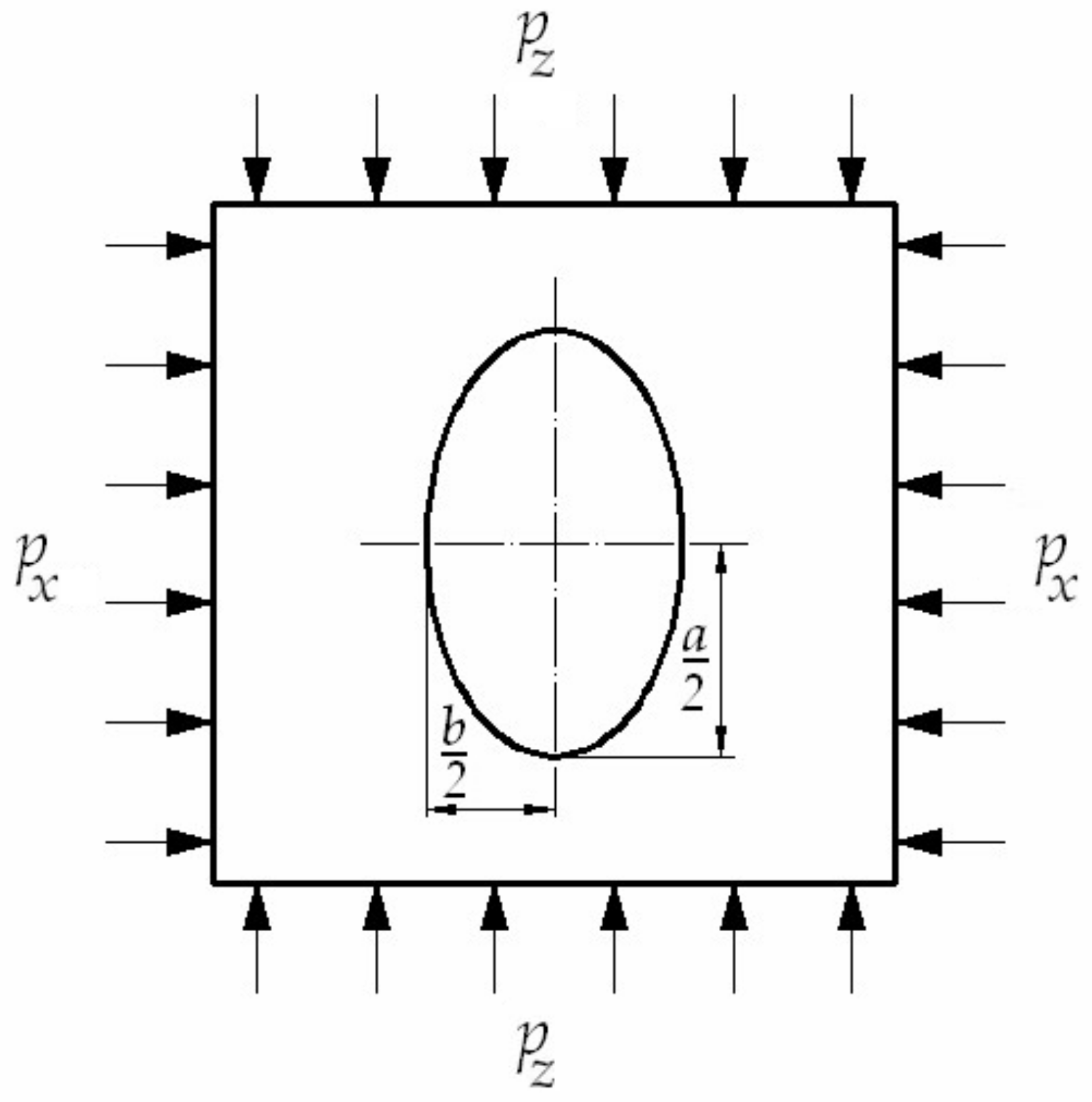
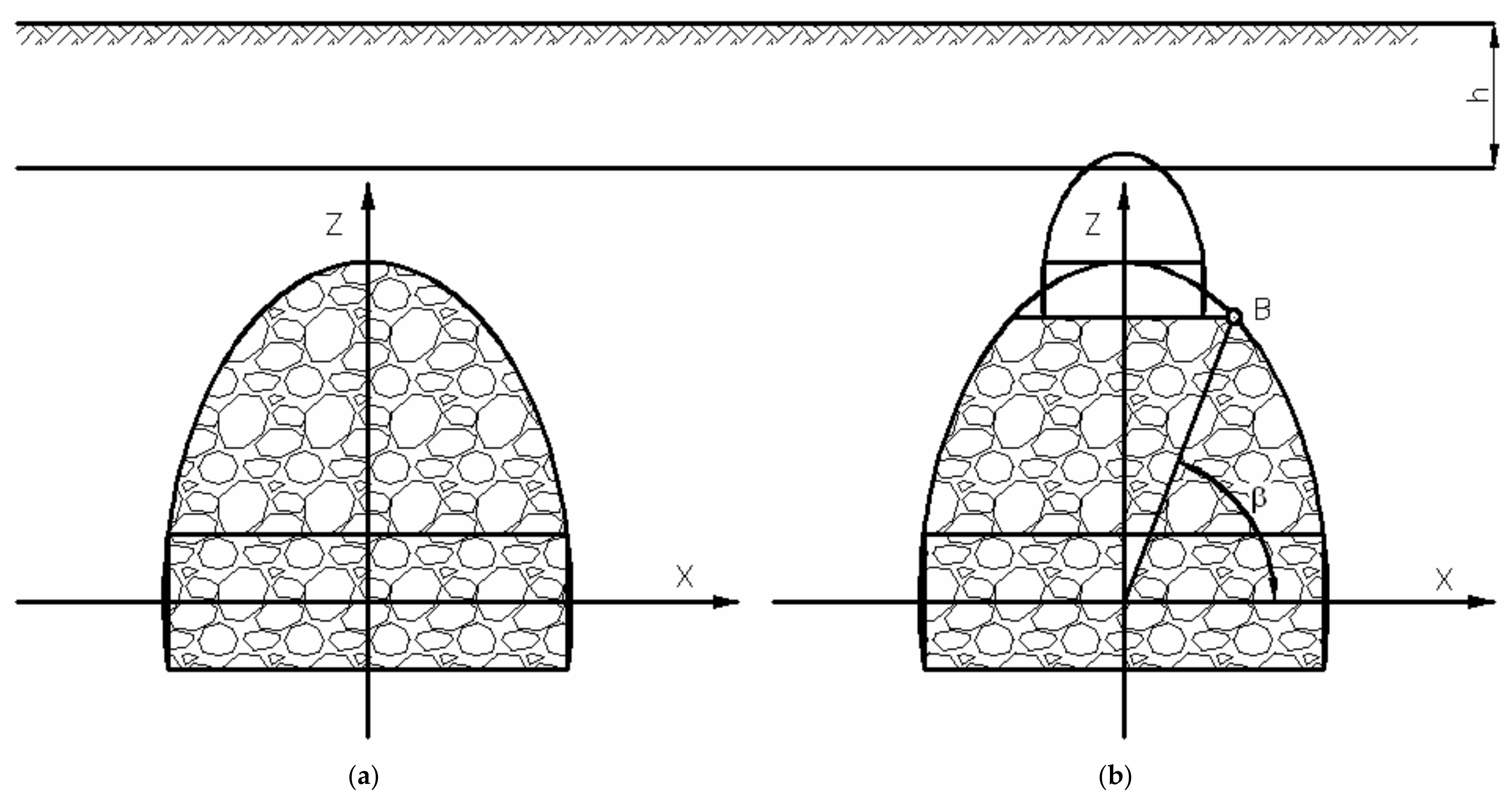

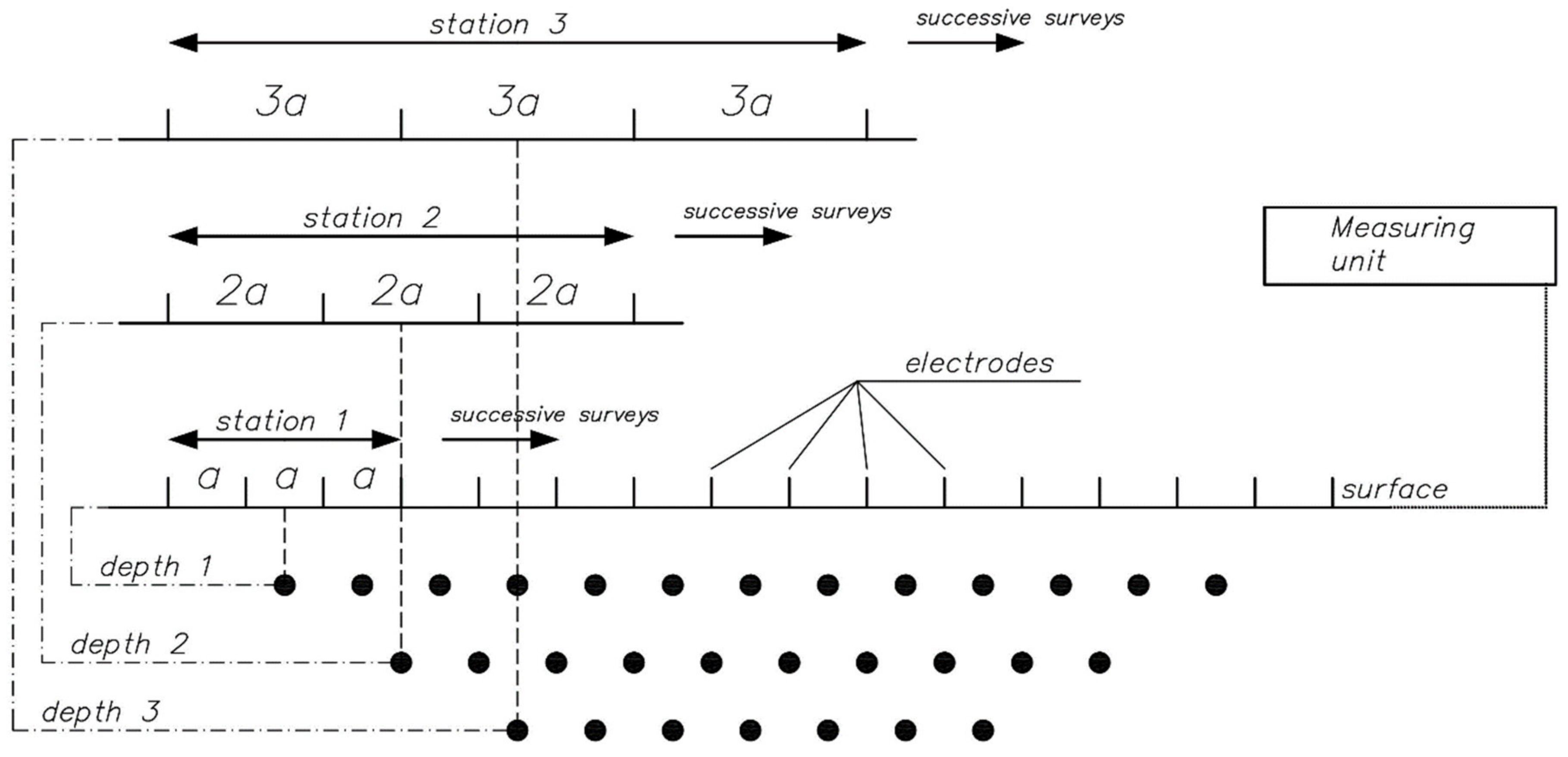
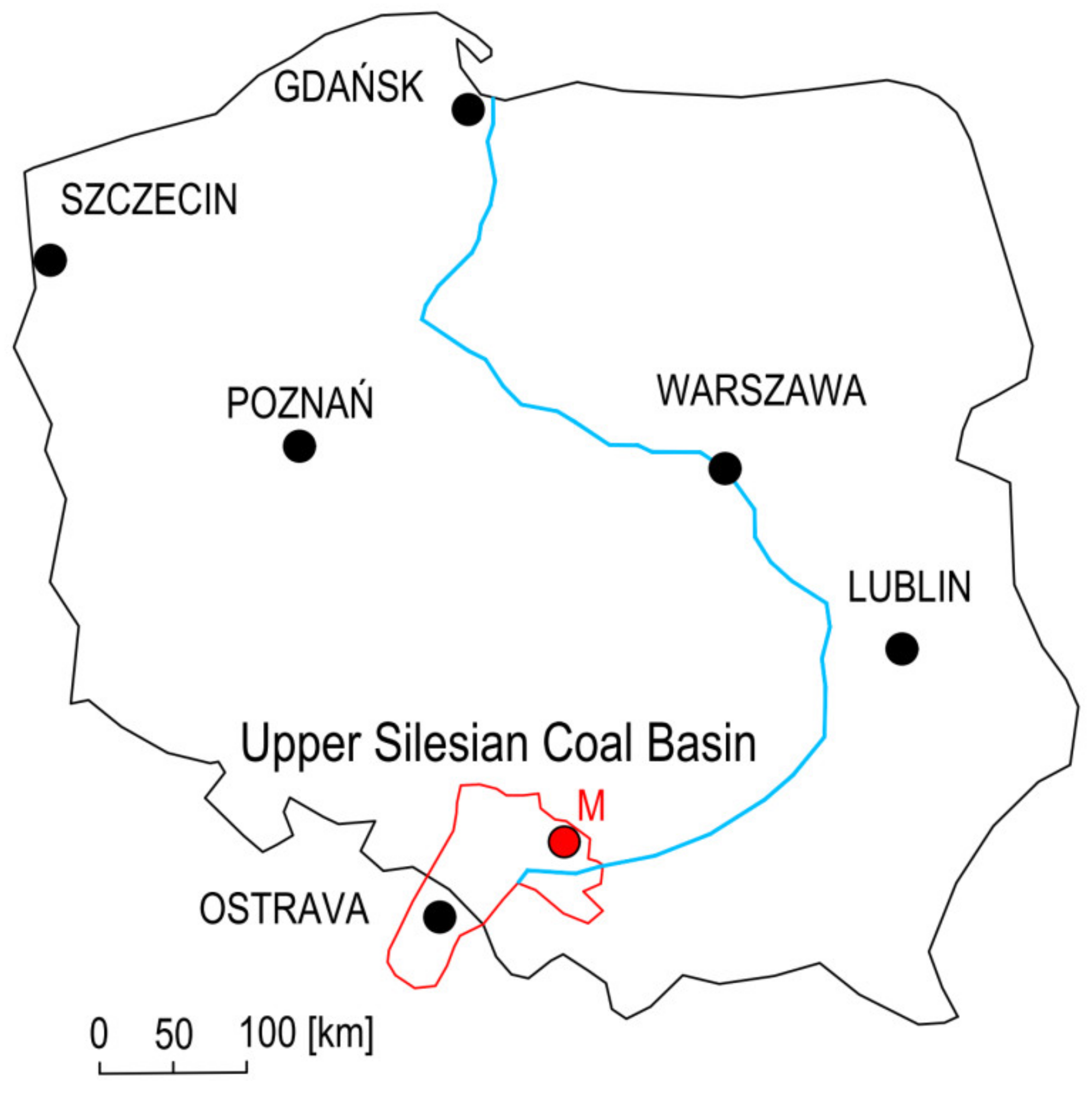


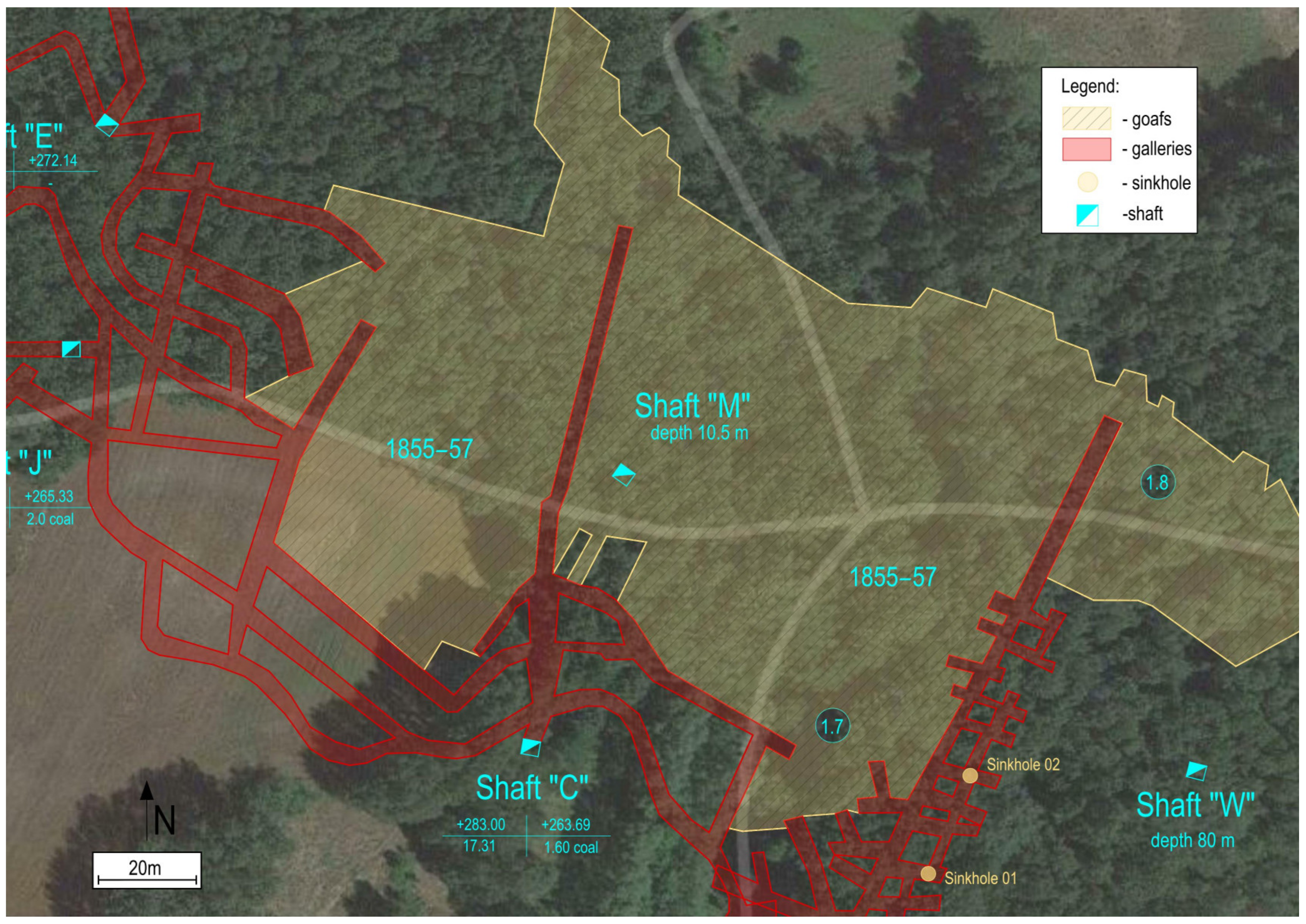
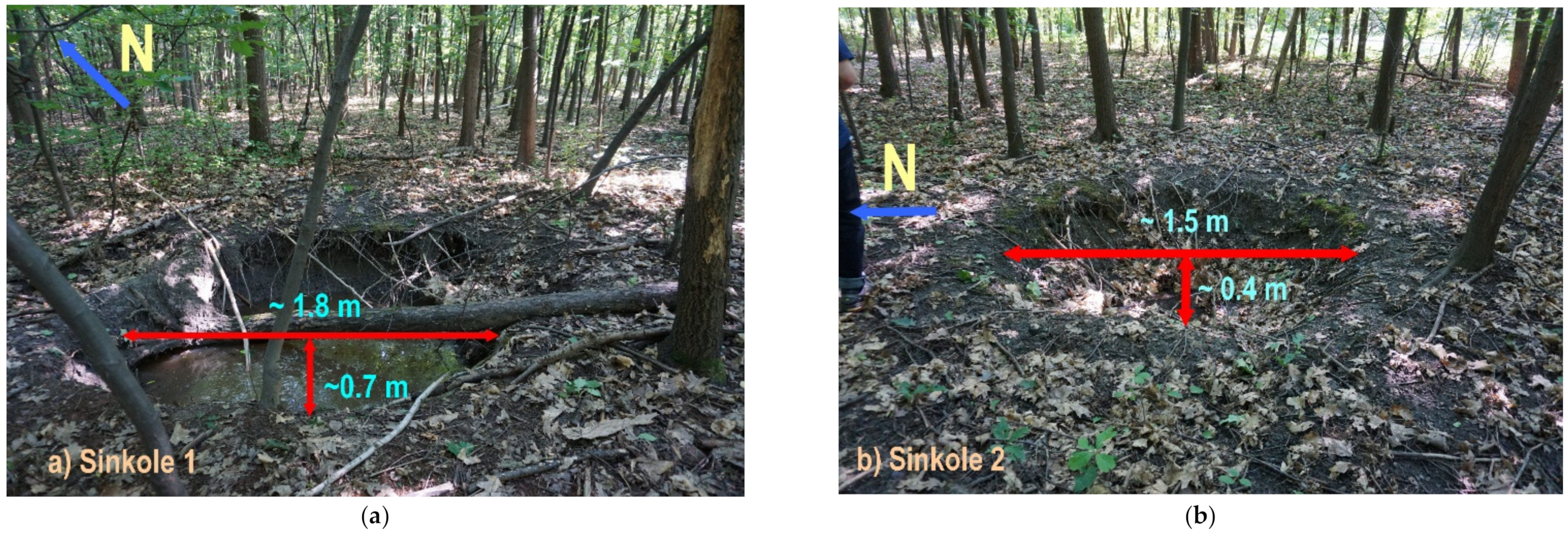

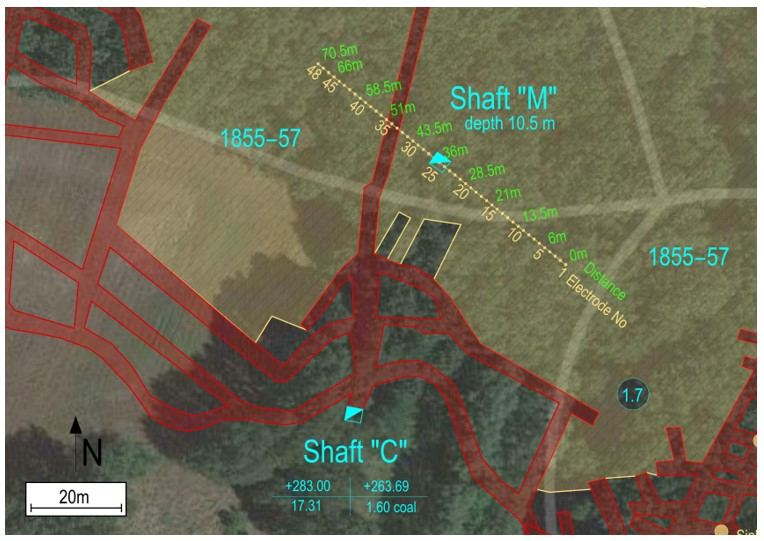
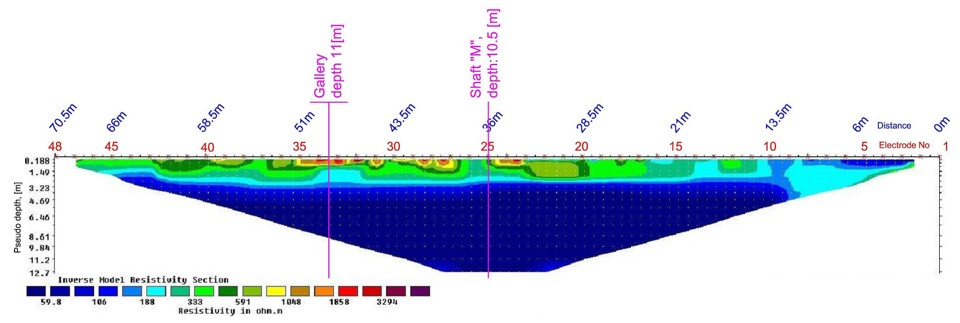
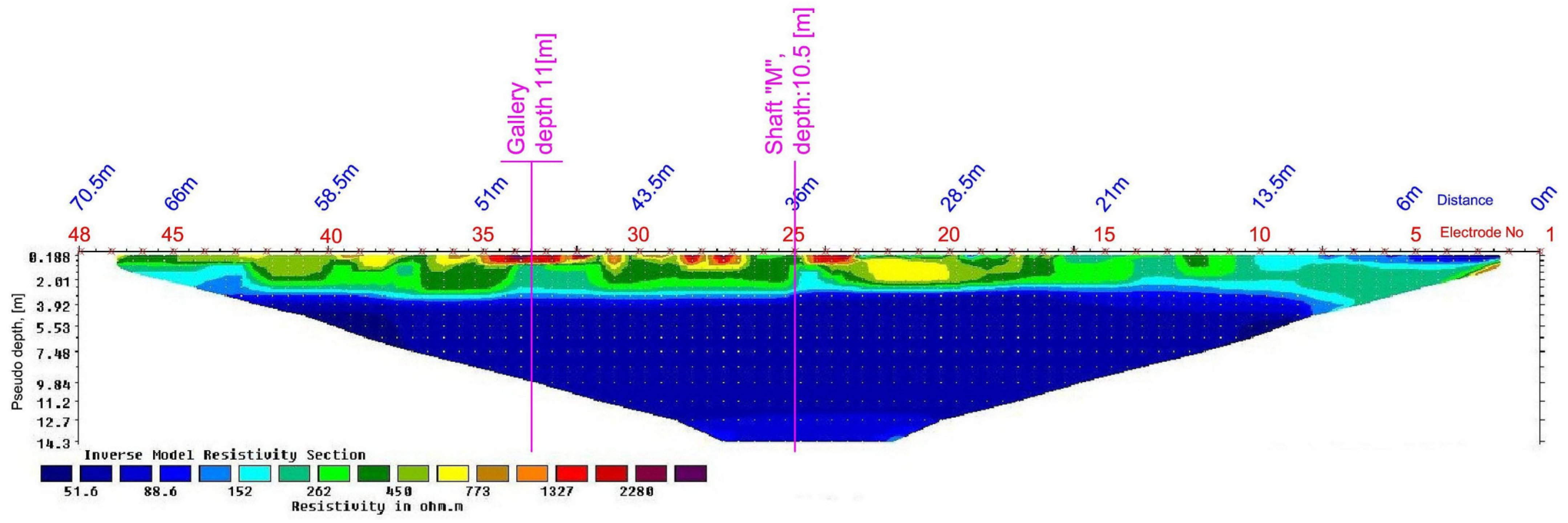
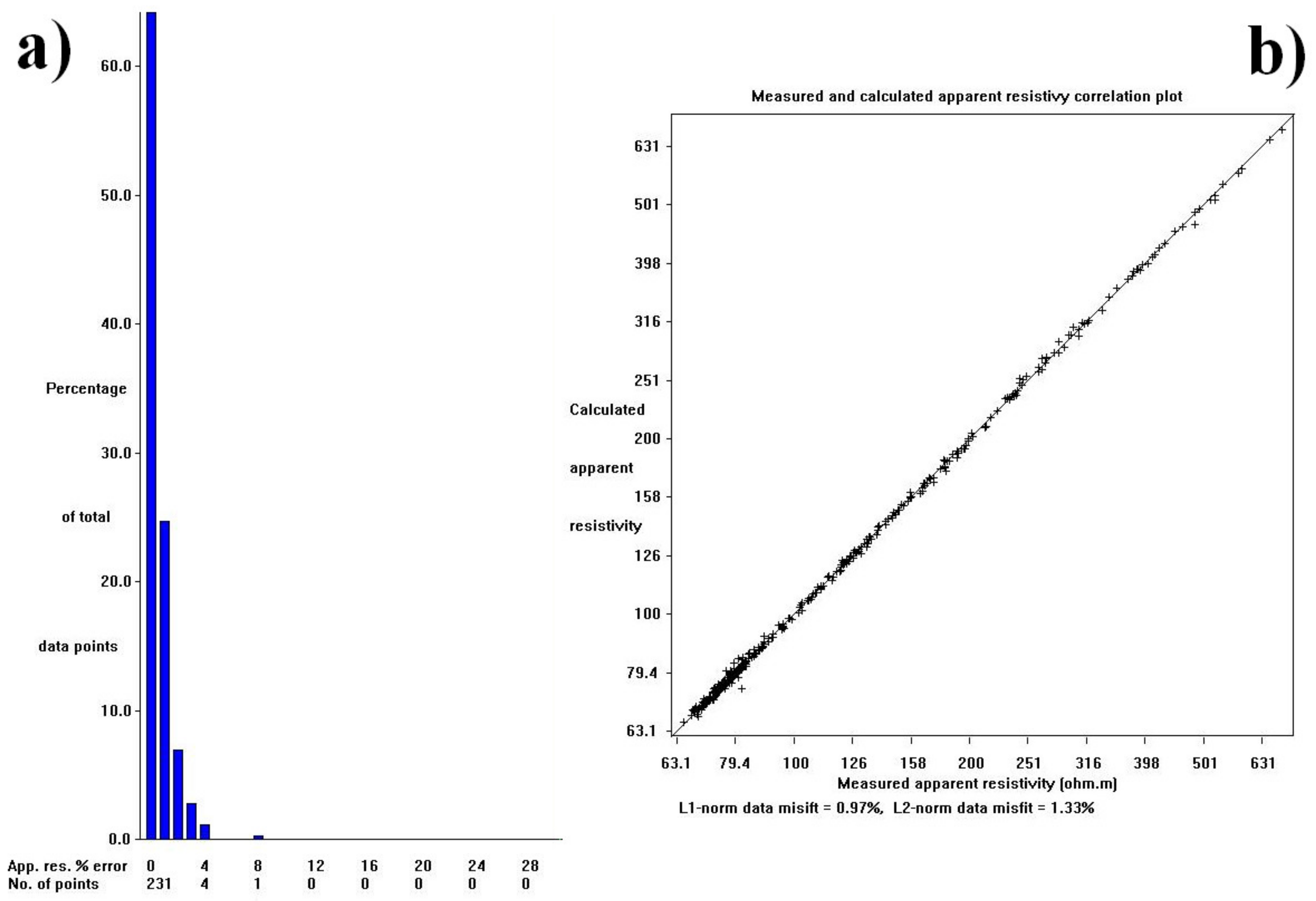
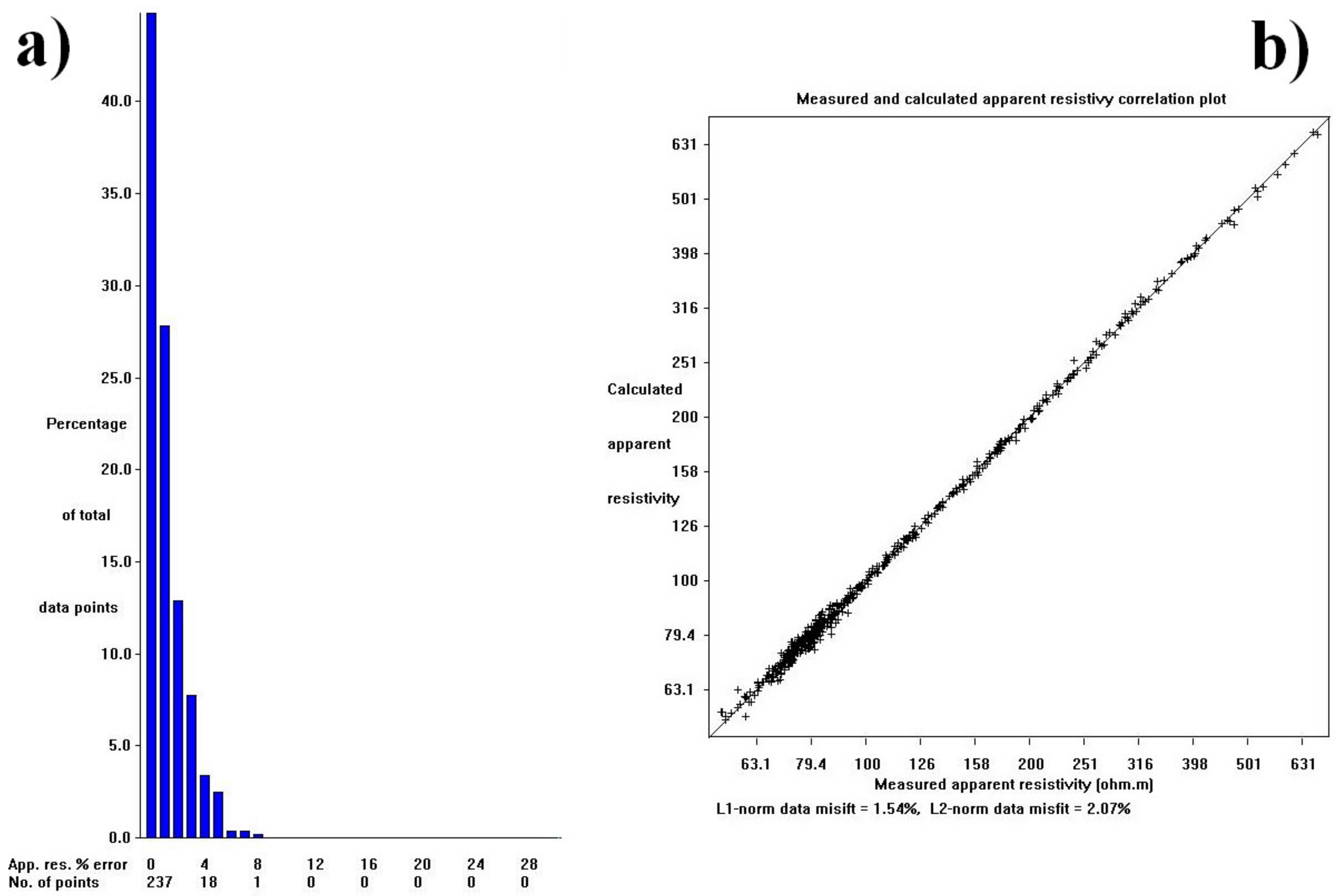
| No. | γ (MN/m3) | Rr(MPa) | kr(−) | hi (m) |
|---|---|---|---|---|
| 1 | 0.027 | 0.02 | 1 | 10.9 |
| 2 | 0.025 | 0.5 | 1.15 | 4.7 |
| 3 | 0.015 | 1.1 | 1.1 | 1.7 |
Publisher’s Note: MDPI stays neutral with regard to jurisdictional claims in published maps and institutional affiliations. |
© 2021 by the authors. Licensee MDPI, Basel, Switzerland. This article is an open access article distributed under the terms and conditions of the Creative Commons Attribution (CC BY) license (https://creativecommons.org/licenses/by/4.0/).
Share and Cite
Strzałkowski, P.; Ścigała, R.; Szafulera, K.; Kołodziej, K. Surface Deformations Resulting from Abandoned Mining Excavations. Energies 2021, 14, 2495. https://doi.org/10.3390/en14092495
Strzałkowski P, Ścigała R, Szafulera K, Kołodziej K. Surface Deformations Resulting from Abandoned Mining Excavations. Energies. 2021; 14(9):2495. https://doi.org/10.3390/en14092495
Chicago/Turabian StyleStrzałkowski, Piotr, Roman Ścigała, Katarzyna Szafulera, and Konrad Kołodziej. 2021. "Surface Deformations Resulting from Abandoned Mining Excavations" Energies 14, no. 9: 2495. https://doi.org/10.3390/en14092495
APA StyleStrzałkowski, P., Ścigała, R., Szafulera, K., & Kołodziej, K. (2021). Surface Deformations Resulting from Abandoned Mining Excavations. Energies, 14(9), 2495. https://doi.org/10.3390/en14092495





